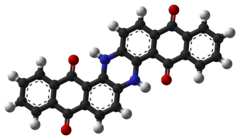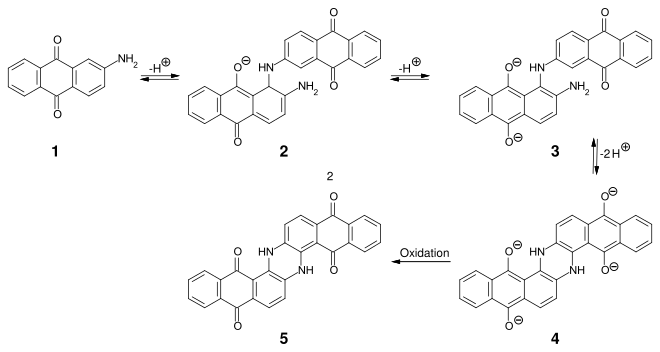Indanthrone blue

| |

| |
| Names | |
|---|---|
| Preferred IUPAC name
6,15-Dihydrodinaphtho[2,3-a:2′,3′-h]phenazine-5,9,14,18-tetrone | |
| Other names
C.I. vat blue 4, carbon paper blue, blue O, carbanthrene blue 2R, fenan blue RSN, graphtol blue RL, medium blue, monolite fast blue 3R, indanthrene, indanthrone, pigment blue 60, C.I. 69800
| |
| Identifiers | |
3D model (JSmol)
|
|
| 367131 | |
| ChemSpider | |
| ECHA InfoCard | 100.001.251 |
| E number | E130 (colours) |
PubChem CID
|
|
| UNII | |
CompTox Dashboard (EPA)
|
|
| |
| |
| Properties | |
| C28H14N2O4 | |
| Molar mass | 442.430 g·mol−1 |
| Appearance | dark blue solid |
| Density | 1.6 g/ml |
| Melting point | 470-500 °C (decomposes) |
| Insoluble | |
Except where otherwise noted, data are given for materials in their standard state (at 25 °C [77 °F], 100 kPa).
| |
Indanthrone blue, also called indanthrene, is an organic compound with the formula (C14H6O2NH)2. It is a dark blue solid that is a common dye as well as a precursor to other dyes.[1]
Preparation[edit]
The compound made from 2-aminoanthraquinone treated with potassium hydroxide.
By dimerization of 2-aminoanthraquinone (1) under strongly alkaline conditions at 220-235 °C, the intermediate 3 is obtained in two steps, which cyclizes intramolecularly and is oxidized to indanthrone 5.[2]
Applications[edit]
It is a pigment that can be used in the following media: acrylic, alkyd, casein, encaustic, fresco, gouache, linseed oil, tempera, pastel, and watercolor painting. It is used to dye unmordanted cotton and as a pigment in quality paints and enamels. As a food dye, it has E number E130, but it is not approved for use in either the United States or the European Union.[3][4] It has excellent light fastness, but may bleed in some organic solvents.
Organic Semiconductor[edit]
As an organic semiconductor, indanthrone has capabilities for utilization as a photocatalyst for oxygen generation from water utilizing solar energy.[5][6] Indanthrone's characteristic as a nonlinear optics light absorber, allows for its use as an optical limiter, which can be employed, for instance, in laser protective filters.[7]
Colorant[edit]
Indanthrone is utilized as a blue pigment (C.I. Pigment Blue 60), primarily in the process of vat dyeing, often referred to as C.I. Vat Blue 4.[8] Indanthrone is a vat dye, synthesized to provide highest color fastness for the dyeing and printing of predominantly cellulose-based textile fibers. Fabrics dyed with indanthrene fulfill the highest standards and exhibit exceptional wash fastness, boil fastness, light fastness, weather fastness and chlorine fastness.
Trademark[edit]
Indanthrone blue was the first example of the brand "Indanthren" (an acronym for Indigo from anthracene) introduced by BASF in 1901.[9][10][11] One result is that even now, in Japan vat dyes are commonly described as thren(e) dyes (スレン染料), derived from the Japanese transliteration of the brand.[12][13]
References[edit]
- ^ Bien, Hans-Samuel; Stawitz, Josef; Wunderlich, Klaus (2000). "Anthraquinone Dyes and Intermediates". Ullmann's Encyclopedia of Industrial Chemistry. doi:10.1002/14356007.a02_355. ISBN 3527306730.
- ^ Heinrich Zollinger (2003), [[1], p. 289, at Google Books Color Chemistry: Syntheses, Properties, and Applications of Organic Dyes and Pigments] (3. ed.), Weinheim: WILEY-VCH Verlag, p. 289, ISBN 3-906390-23-3
{{citation}}: Check|url=value (help) - ^ Summary of Color Additives for Use in the United States in Foods, Drugs, Cosmetics, and Medical Devices, Food and Drug Administration
- ^ Current EU approved additives and their E Numbers, Food Standards Agency
- ^ C. A. Linkous, D. K. Slattery: Solar photocatalytic hydrogen production from water using a dual bed photosystem. In Proceedings of the 2000 Hydrogen Program Annual Review, Volume I. (PDF).
- ^ D. K. Slattery et al: Semiempirical MO and Voltammetric estimation of ionization potentials of organic pigments. Comparison to gas phase ultraviolet photoelectron spectroscopy. In: Dyes and Pigments 49, 2001, pp. 21-27.
- ^ Y.-P. Sun, J. E. Riggs: Organic and inorganic optical limiting materials. From fullerenes to nanoparticles. In International Reviews in Physical Chemistry. 18, no. 1, 1999, pp. 43-90.
- ^ W. Herbst, K. Hunger: Industrial Organic Pigments. Preparation, properties, application. 2nd ed., Wiley-VCH, Weinheim 1995, ISBN 3-527-28744-2.
- ^ Entry on Indanthron-Pigmente. at: Römpp Online. Georg Thieme Verlag, retrieved 16. Januar 2013.
- ^ "Marken - Registerauskunft - Indanthren". DPMAregister (in German). Retrieved 29 August 2020.
Anmeldetag: 05.08.1901 / Inhaber: BASF AG
- ^ Zollinger, Heinrich (2003). Color Chemistry: Syntheses, Properties, and Applications of Organic Dyes and Pigments. John Wiley & Sons. p. 255. ISBN 978-3-906390-23-9. Retrieved 29 August 2020.
The German word Indanthren is an acronym for Indigo aus Anthrazen
- ^ "Colourful World III". www.eonet.ne.jp. Retrieved 29 August 2020.
バット染料の主たる製造元は、ドイツの化学会社でありその時の商標が、 "インダンスレン" であったことからスレン染料と呼ぶ場合も多くあります
- ^ "アルテモンド 豆知識 / スレン染料". www.artemondo.co.jp.
スレン染料(threne dye)とは、バット染料(vat dye)の俗称

